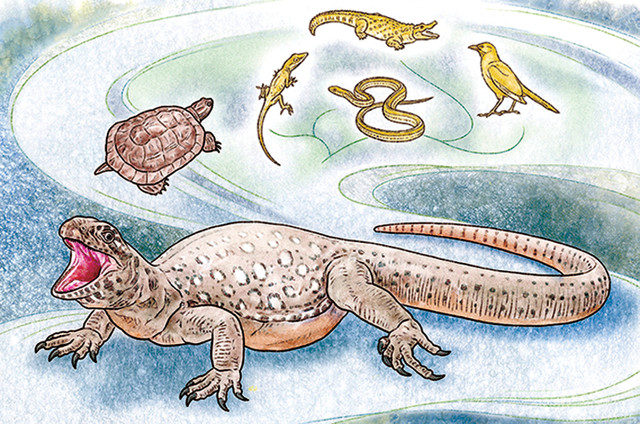
by Mary Caperton Morton Wednesday, December 23, 2015

Eunotosaurus lacked a full shell, but it had other characteristics that indicate it was likely an early ancestor of modern turtles. Credit: Mick Ellison.
Turtles may seem like innocent creatures, but the uniquely shelled reptiles have long posed a problem for paleontologists. Shelled turtles are plentiful in the fossil record, but specimens of their intermediate forebears — the missing links between ancestral unshelled reptiles and modern turtles — have remained elusive. Now, a closer look at the skull of what may be one of the earliest turtle relatives is filling gaps in the turtle family tree.
One of the biggest problems in understanding turtle evolution “is that the earliest turtles we knew of in the fossil record, dating to about 210 million years ago, already have the full shell,” says Gabe Bever, a paleontologist at the New York Institute of Technology at Old Westbury and lead author of the new study, published in Nature. “There should be intermediate forms that look half like a turtle and half something else.”
The quest to fill in the early turtle family tree has been boosted in recent years by a 260-million-year-old animal called Eunotosaurus. Originally discovered in 1890 in South Africa, but only recently described in detail, Eunotosaurus possesses characteristics that seem to place it between reptiles and turtles. For example, it does not have a shell, but it does have wide ribs like a turtle, Bever says, and it “breathed in a unique way that’s only found in modern turtles” — by moving its belly muscles, forcing the lungs to get larger and smaller, he says.
In the new study, Bever focuses on Eunotosaurus' skull, which shares some obvious characteristics with modern turtle skulls, such as a shortened face, as well as some less-obvious features. CT scans of three different skulls revealed two holes, known as the upper and lower temporal fenestrae, behind each eye. These holes are the defining characteristic of diapsid skulls, which all living reptiles possess, except turtles.
“The diapsid condition allows the fibers of the jaw muscles to lengthen, which is typically associated with a quicker bite,” a morphology that likely evolved for grabbing insects, Bever says. “Modern turtles don’t have that. They have an anapsid skull with a solid skull roof behind the eye.”
Turtles' anapsid skulls are one of the reasons paleontologists have long thought they may have evolved from a much more ancient lineage that’s unrelated to other modern reptiles. Finding the temporal fenestrae in Eunotosaurus suggests that turtles started as diapsids and evolved to become anapsids, which previous studies relying on molecular data from DNA have also suggested. “This study sides with the molecular data and shows pretty conclusively that turtles are part of the modern reptile radiation,” Bever says.
The findings also line up with other recently published fossil evidence, says Jérémy Anquetin, a vertebrate paleontologist at the JURASSICA Museum in Porrentruy, Switzerland, who was not involved in the new research. “This paper quite convincingly proves the link between the cranial anatomy of Eunotosaurus and turtles. And last June, another [Nature] paper presented a [220-million-year-old] turtle from the Triassic of Germany that can be seen as an intermediate between Eunotosaurus and early turtles,” he says. “So we have all these pieces coming together. It seems we may finally be on the right track to find the origin of turtles.”
Important gaps in the fossil record remain, however, Bever says. “There was probably 10 million years of evolution [in the turtle lineage] before Eunotosaurus, and about 20 million years between Eunotosaurus and the next known turtle relative,” he says. Productive fossil-bearing localities uncovered in recent years, particularly in China, South Africa and South America (see sidebar) may answer some of the open questions.
“We are working to fill these gaps, but there just aren’t that many people who specialize in turtles,” Anquetin says. Additionally, he points out, “all vertebrate fossils are rare. … And then you have to be lucky enough to find them.”
© 2008-2021. All rights reserved. Any copying, redistribution or retransmission of any of the contents of this service without the expressed written permission of the American Geosciences Institute is expressly prohibited. Click here for all copyright requests.